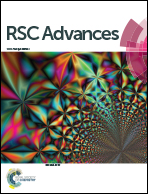Tunable color and energy transfer of Tm3+ and Ho3+ co-doped NaGdF4 nanoparticles
Abstract
NaGdF4:Tm3+, Ho3+ nanoparticles with luminescence properties were synthesized by a hydrothermal method. The morphology, structure and properties of the obtained samples were investigated in detail. The results indicate that the samples are pure hexagonal NaGdF4. The luminescence properties reveal that the samples can emit blue and green light under 359 nm UV light excitation. It is found that in the Tm3+, Ho3+ co-doped NaGdF4 system, the efficient energy transfer from Tm3+ to Ho3+ is observed from the photoluminescence spectra and the fluorescence decay curves. Furthermore, the hues can be adjusted from blue through to light blue and ultimately to bluish green. It is clear that these β-NaGdF4 nanoparticles could have potential applications in fields such as solid-state lighting and color displays.


 Please wait while we load your content...
Please wait while we load your content...